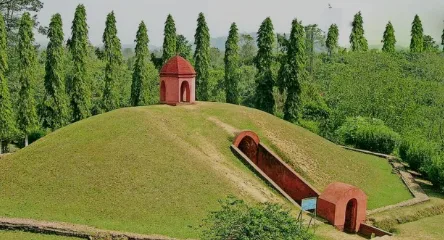The Moidams of Assam, a distinctive mound-burial system of the Ahom dynasty, have been inscribed on the Unesco World Heritage List. This significant addition brings the total number of Indian sites on the list to 43, positioning India as sixth globally for the most world heritage properties.
The announcement was made during the 46th World Heritage Committee meeting, which is being hosted in India for the first time at Bharat Mandapam. The Moidams, recognised as the first cultural site from North-East India to achieve this honour, were India’s nomination for the 2023-24 cycle. This year’s list includes 27 nominations from around the world, encompassing 19 cultural sites, four natural sites, two mixed sites, and two significant boundary modifications. This marks Assam’s third entry on the World Heritage List, following the inclusion of Kaziranga National Park and Manas Wildlife Sanctuary in 1985, both recognised under the natural category. The Moidams, specifically located in the Charaideo region, are celebrated for their monumental architecture which parallels the pyramids of ancient Egypt and the royal tombs of China in terms of grandeur and historical significance.
Prime Minister expressed his elation on social media, stating, “It is a matter of immense joy and pride for India. The Moidams embody the illustrious Ahom culture, demonstrating profound respect for ancestors. I hope this recognition increases awareness of the remarkable Ahom dynasty and its cultural heritage.” The Minister of Culture and Tourism remarked that this inclusion is poised to enhance tourism in the region. “Since 2014, 13 Indian sites have been added to the World Heritage List. This development could significantly boost regional tourism,” he noted.
The Moidams, situated in the foothills of the Patkai ranges in eastern Assam, hold sacred significance for the Tai-Ahom community. These burial mounds, constructed over a span of 600 years from the 13th to the 19th century CE, utilise natural elements such as hills, forests, and water to form a unique and sacred landscape. This inclusion not only celebrates the rich historical and cultural heritage of Assam but also elevates India’s status in the global heritage arena, reflecting the country’s commitment to preserving and showcasing its diverse cultural assets.



